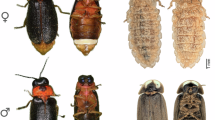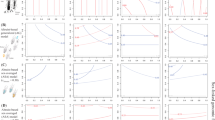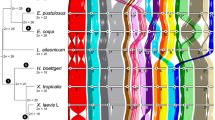Abstract
Tribolium castaneum and T. freemani produce sterile hybrid progeny in reciprocal crosses. The reciprocal crosses differ significantly in the mean numbers of progeny, progeny sex ratios, hybrid male body size and male antennal and leg morphologies. These results suggest an effect of either the X chromosome or the cytoplasm on characteristics of F1 hybrids. In contrast, large X chromosome effects on morphological traits are not usually oberved in interspecific crosses among drosophilid flies. We also report large, significant differences in progeny numbers, body mass and degree of female bias in sex ratio between different geographic strains of T. castaneum when mated in reciprocal crosses with T. freemani. Sex ratio bias also varies significantly among matings within geographic strains of T. castaneum. When T. castaneum males are mated with T. freemani females, but not in the reciprocal cross, the F1 sex ratio is female biased, uncorrelated with family size and ranges from 57.14 per cent to 72.23 per cent female, depending on the geographic strain of the T. castaneum male.
Similar content being viewed by others
Article PDF
References
Bock, I R. 1984. Interspecific hybridizations in the genus Drosophila. Evol Biol, 18, 41–70.
Brownlee, A, and Sokoloff, A. 1988. Transmission of Tribolium castaneum (Herbst) mutants to T. castaneum-T. freemani Hinton hybrids (Coleoptera: Tenebrionidae). J Stored Prod Res, 24, 145–150.
Carson, H L. 1975. The genetics of speciation at the diploid level. Am Nat, 109, 83–92.
Charlesworth, B, Coyne, J A, and Barton, N H. 1987. The relative rates of evolution of sex chromosomes and autosomes. Am Nat, 130, 113–146.
Coyne, J A. 1974. The evolution of hybrid inviability. Evolution, 28, 505–506.
Coyne, J A. 1985. Genetic studies of three sibling species of Drosophila with relation to theories of speciation. Genet Res, 46, 169–192.
Coyne, J A. 1992a. Genetics of sexual isolation in females of the Drosophila simulans species complex. Genet Res, 60, 25–31.
Coyne, J A. 1992b. Genetics and speciation. Nature, 355, 511–515.
Coyne, J A. 1993. The genetics of an isolating mechanism between two sibling species of Drosophila. Evolution, 47, 778–788.
Coyne, J A, and Orr, H A. 1989a. Two rules of speciation. In: Otte, D. and Endler, J. (eds) Speciation and its Consequences, pp. 180–207. Sinauer Press, Sunderland, MA.
Coyne, J A, and Orr, H A. 1989b. Patterns of speciation in Drosophila. Evolution, 43, 362–381.
Coyne, J A, Orr, H A, and Futuyma, D J. 1988. Do we need a new species concept? Syst Zool, 37, 190–200.
Crow, J F. 1942. Cross fertility and isolating mechanisms in the Drosophila mulleri group. University of Texas Publication 4228, pp. 53–67.
Dobzhansky, Th. 1937. Genetics and the Origin of Species. Columbia University Press, New York.
Haldane, J B S. 1922. Sex ratio and unisexual sterility in hybrid animals. J Genet, 12, 101–109.
Hinton, H E. 1948. A synopsis of the genus Tribolium MacLeay, with some remarks on the evolution of its species-groups (Coleoptera: Tenebronidae). Bull Ent Res, 39, 13–55.
Hutter, P, Roote, J, and Ashburner, M. 1990. A genetic basis for the inviability of hybrids between sibling species of Drosophila. Genetics, 124, 909–920.
Johnson, N A, and Wu, C I. 1993. Evolution of postulating reproductive isolation: measuring the fitness effects of chromosomal regions containing hybrid male sterility factors. Am Nat, 134, 213–223.
McCauley, D E, and Wade, M J. 1980. Group selection: the phenotypic and genotypic differentiation of small populations. Evolution, 34, 813–821.
Mayr, E. 1963. Animal Species and Evolution. Harvard University Press, Cambridge, MA.
Nakakita, H, Imura, O, and Winks, R G. 1981. Hybridization between Tribolium freemani (Hinton) and Tribolium castaneum (Herbst) and some preliminary studies on the biology of Tribolium freemani (Coleoptera, Tenebrionidae). Appl Ent Zool, 16, 209–215.
Nei, M, Maruyama, T, and Wu, C-I. 1983. Models of evolution of reproductive isolation. Genetics, 103, 557–579.
Orr, H A. 1993. Haldane's rule has multiple genetic causes. Nature, 361, 532–533.
Park, T. 1933. Studies in population physiology. II. Factors regulating initial growth of Tribolium confusum populations. Exp Zool, 65, 17–42.
Park, T, Leslie, P H, and Mertz, D B. 1964. Genetic strains and competition in populations of Tribolium. Phys Zool, 37, 97–161.
Partridge, L. 1993. Haldane's rule and the hazards of heterogametity. Curr Biol, 3, 56–58.
Sawamura, K, Taira, T, and Watanabe, T K. 1993. Hybrid lethal systems in the Drosophila melanogaster species complex. I. The maternal hybrid rescue (mhr) gene of Drosophila simulans. Genetics, 133, 299–305.
Sawamura, K, Yamomoto, M-T, and Watanabe, T K. 1993b. Hybrid lethal systems in the Drosophila melanogaster species complex. II. The Zygotic lethal rescue gene of Drosophila melanogaster. Genetics, 133, 307–313.
Sokoloff, A. 1974. The Biology of Tribolium, 2. Clarendon Press, Oxford.
Spicer, O C. 1991. The genetic basis of a species-specific character in the Drosophila virilis species group. Genetics, 128, 331–337.
Templeton, A R. 1977. Analysis of head shape differences between two interfertile species of Hawaiian Drosophila. Evolution, 31, 630–641.
Templeton, A R. 1980. The theory of speciation via the founder principle. Generics, 94, 1011–1038.
Wade, M J. 1977. An experimental study of group selection. Evolutional, 134–153.
Wade, M J, and Beeman, R. 1994. The population dynamics of maternal-effect selfish genes. Genetics (in press).
Wade, M J, Patterson, H, Chang, N, and Johnson, N A. 1994. Postcopulatory, prezygotic isolation in flour beetles. Heredity, 72, 163–167.
Watanabe, T K. 1979. A gene that rescues the lethal hybrids between Drosophila melanogaster and D. simulans. Jpn J Genet, 52, 1–8.
Wu, C I. 1992. A note on Haldane's rule: Hybrid stability versus hybrid inviability. Evolution, 46, 1584–1587.
Wu, C I, and Davis, A W. 1993. The composite nature of Haldane's rule and its genetic bases. Am Nat, 134, 189–212.
Author information
Authors and Affiliations
Rights and permissions
About this article
Cite this article
Wade, M., Johnson, N. Reproductive isolation between two species of flour beetles, Tribolium castaneum and T. freemani: variation within and among geographical populations of T. castaneum. Heredity 72, 155–162 (1994). https://doi.org/10.1038/hdy.1994.22
Received:
Issue date:
DOI: https://doi.org/10.1038/hdy.1994.22
Keywords
This article is cited by
-
Tribolium beetles as a model system in evolution and ecology
Heredity (2021)
-
Establishment of F1 hybrid mortality in real time
BMC Evolutionary Biology (2017)
-
Sperm competition and offspring viability at hybridization in Australian tree frogs, Litoria peronii and L. tyleri
Heredity (2010)
-
Current reproductive isolation between ancestors of natural hybrids in Bacillus stick insects (Insecta: Phasmatodea)
Heredity (1996)
-
Incipient speciation in the flour beetle, Tribolium confusum: premating isolation between natural populations
Heredity (1995)



